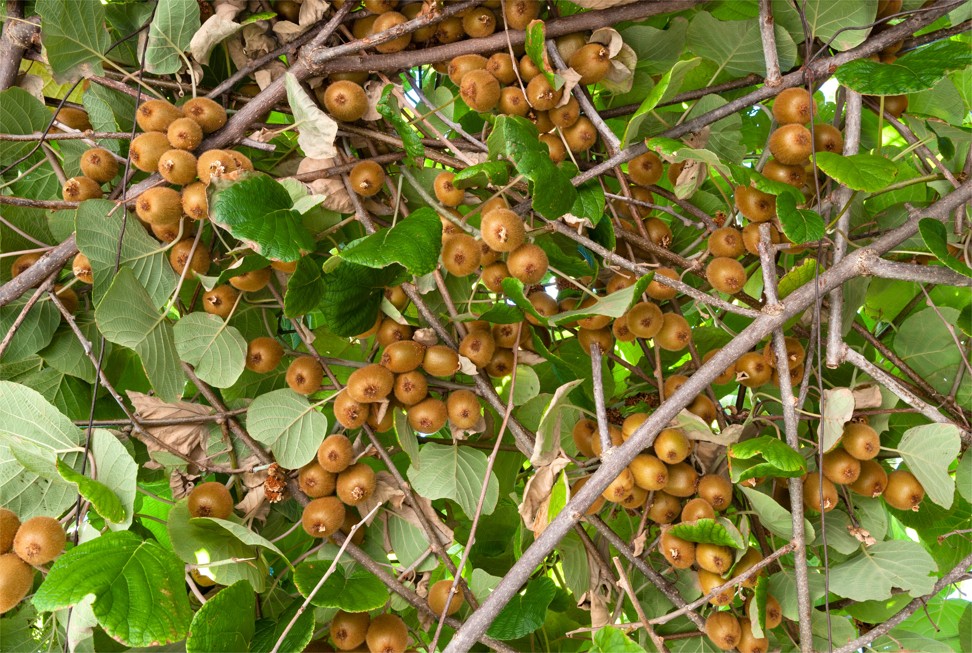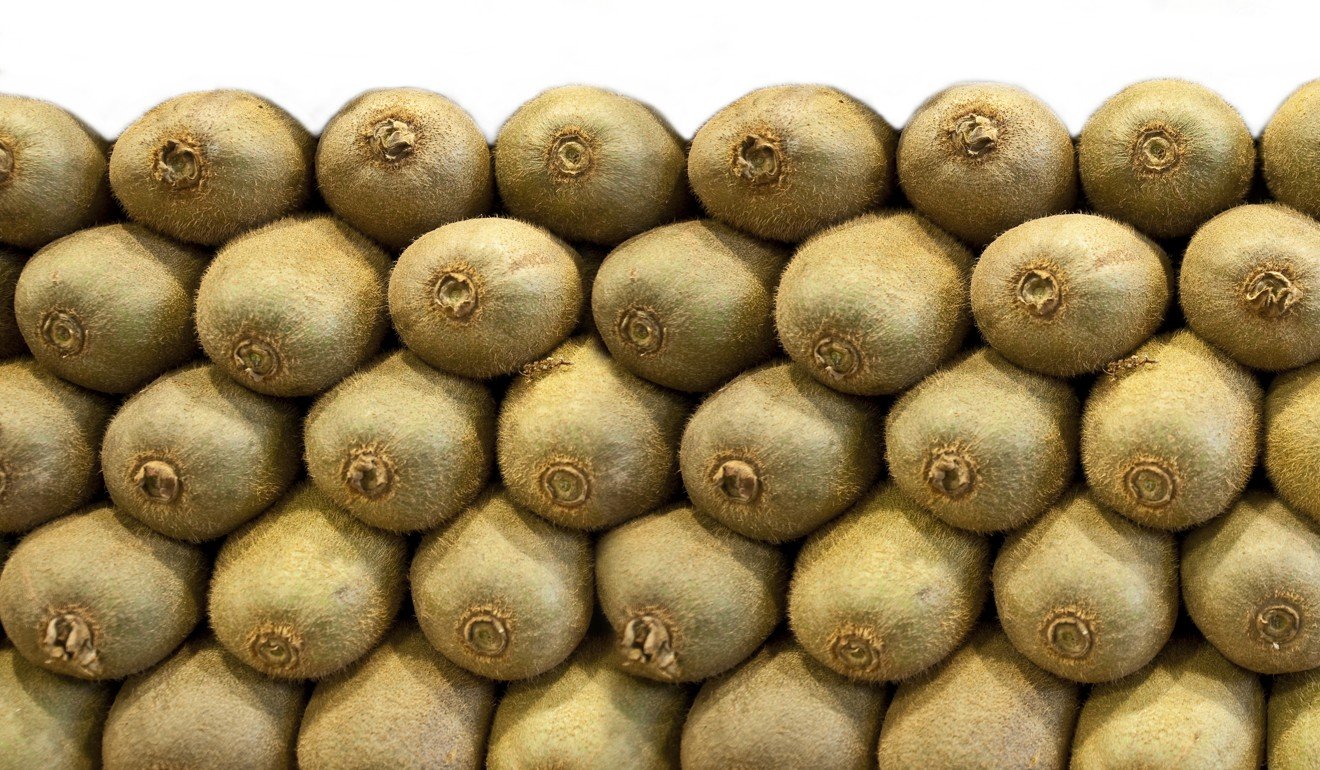
How the kiwi fruit from China, rebranded by New Zealand, flourishes in Italy, now world’s No 2 producer
- Decades ago farmers south of Rome began ripping out grape vines and replacing them with kiwi fruit vines; today harvests in Italy outstrip those in New Zealand
- Rising temperatures have allowed Italian farmers to grow other exotic fruit – avocados, bananas, papaya, mangoes, dragon fruit, guava, even coffee and cocoa
Most people assume the kiwi fruit comes from New Zealand because of its name – which it shares with the country’s flightless bird and is also a nickname for its citizens.
The misunderstanding undoubtedly derives from the fact that the country developed the first commercially viable kiwi for export and today is the world’s third-largest producer of the fruit.
Yet the kiwi, also known as the Chinese gooseberry, is actually native to China, which is the world’s largest producer of the popular fruit. Italy, strangely enough, is the world’s second-largest producer, eclipsing even New Zealand.
The vitamin-rich, bittersweet, juicy green kiwi fruit is a favourite of agronomist and researcher Ottavio Cacioppo, who introduced the first kiwi fruit plants to Italy in 1971 when he was looking for alternative crops suitable for rejuvenating the rural economy of the country’s poorer south.

“At first glance it is not a beautiful fruit, but once split open it’s delicious, precious and highly nutritious,” Cacioppo says. “I fell in love with it at first sight.”
Kiwi fruit vines are flourishing in a former marshland now called the Pontine Plains, midway between Rome and Naples. For centuries, the marshes were a malaria-infested wasteland.
Even the ancient Romans fled the area, declaring it off-limits due to its nasty smells and black swamps, believing it to be a doorway leading to the hellish Roman underworld of Hades.
China was growing kiwi fruit a long time before New Zealand even knew what it was, but … until a few years ago there was no official data on Chinese production
The Pontine region was eventually tamed by fascist dictator Benito Mussolini in the 1930s to recover land for rural use. After the construction of a system of canals and bridges, the water was drained from the marshes and new towns were built for World War I refugees who had lost their homes in northern Italy.
Generations of farming families flourished in the region’s rural estates and today the Pontine Plains are known as Italy’s “Green Heart” for their abundance of vegetation and the lush fruit orchards, which have led locals to embrace healthy lifestyles and eating habits.
Known in Italy as the Agro Pontino, in the administrative region of Lazio, the location is spectacular. The land rises close to the sea, overlooking the tall, protected sand dunes typical of the Mediterranean bush.
Vast fluorescent-green meadows begin at the foot of rugged hills where picturesque hamlets are hidden. Dotted with lakes and canals, the Pontine Hills are now home to eucalyptus trees, and grazing cows and buffaloes.

The area is also home to the historic coastal town of Anxur-Terracina, built by the ancient Greeks when they colonised Italy before the rise of the Roman Empire.
Visitors exploring the area – dubbed “Little New Zealand” – are likely to mistake the low-cut, neat kiwi fruit plants for grape vines, but a closer look at what initially appears to be huge, hairy grapes dispels any doubts.
“There’s a special microclimate here that is optimal for kiwi plantations,” says Mauro Perpetuini, a local producer who owns 17 hectares of kiwi plants and has adopted biological growing techniques to respect the environment.
“Temperatures are mild due to the nearby sea, some five degrees warmer than Rome, which is just 60 kilometres (37 miles) away. And the former marshes have made the soil very fertile.”

Surrounded by forests where pagan tribes once lived, Perpetuini’s estate is run by his family, and he is proud of the high-quality produce that grows on his land.
“The Pontine kiwis are renowned for having the properties that please the senses: the brightest green colour, and the sweetest flavour, with a delicate bitterness that teases taste buds,” he says.
Kiwi producers in the area have joined forces in a network under the supervision of the local chamber of commerce, which has drawn up tight regulations to ensure a high standard of fruit, similar to rules in place for wine production.

“Kiwi is a Chinese fruit, yet few know it,” says agronomist Cacioppo, who introduced the plants to the region almost 50 years ago.
“China was growing kiwi fruit a long time before New Zealand even knew what it was, but the trouble was that until a few years ago there was no official data on Chinese production, so nobody really had a clear picture. That’s why people were misled to thinking the kiwi was born in New Zealand.”
Cacioppo discusses the fruit with affection, almost as if it were one of his children. “In Italy, like in France, we like to call it the ‘vegetable mouse’ because it really looks like one, with all the fur,” he says.
Cacioppo discovered that the kiwi plant was well-suited to the Pontine Plains’ microclimate after conducting in-depth analysis and on-the-ground testing.
Eating Italian kiwis or papayas is a way to promote national goods and kill food miles [reduce the carbon footprint]. It’s becoming a status symbol, a niche habit, which is spreading
“The territorial boundaries where all the estates are located have the shape of a triangle. Hence I’ve nicknamed it the Golden Triangle,” he says.
Under Cacioppo’s supervision, local farmers converted poor-quality vineyards into premium kiwi fruit plantations that produce a special variety. The fruit grown in the Pontine Plains is smaller than the average kiwi, rounder, with more “fur” and a much thinner skin that easily peels off. Most Italian kiwi enthusiasts gulp the fruit down after rubbing the hair off.
Italy’s love of Chinese fruit is not confined to kiwi. Oranges and lemons – also native to China, where they have been eaten since the Stone Age – have been growing in Italy for centuries. Spots such as the Amalfi Coast and Sorrento are renowned for their deluxe varieties, particularly for the huge, thick-skinned lemons used to make Limoncello liqueur.

The region of Calabria, located on Italy’s boot tip, produces top-quality mandarins larger than oranges and with a thick bright orange rind.
Italy is experiencing an agrarian metamorphosis that has taken an exotic twist. As a result of rising temperatures in the Mediterranean, Italian farmers south of Rome have experimented with alternative crops and are now successfully growing exotic fruits from around the world.
There are also fields of feijoa, pineapple and guava, while experimental coffee and cocoa plantations are increasing in number.

“Exotic fruits have become a fad, a symbol of well-being and a healthy lifestyle,” says Rossella Bianchi, an Italian luxury-food trends expert. “People have discovered they can now grow in their backyard produce they were once forced to import at a high cost.
“Eating Italian kiwis or papayas is a way to promote national goods and kill food miles [reducing the carbon footprint]. It’s becoming a status symbol, a niche habit, which is spreading.”
Clubs and bars in Sicily serve artisan cocktails made with passion fruit, and black sapote juice – from the so-called soap apple, a persimmon with a soft, dark chocolate-like pulp. Gourmands like to spread it on a slice of bread like butter, or scoop it up with a spoon.

The most exclusive non-local fruit, however, is the Australian finger lime, grown in Sicily and in the Pontine Plains a few metres from the sea.
Elegant restaurants across Italy serve fresh fish delicacies sprinkled with finger lime, dubbed “lemon caviar” for its texture and high price. In the chic Aeolian islands, north of Sicily, top chefs have replaced Italian extra virgin olive oil with finger lime juice for dressing, while new lavish food twists have been created, including signature recipes with kiwis and salads with mango and avocado.

